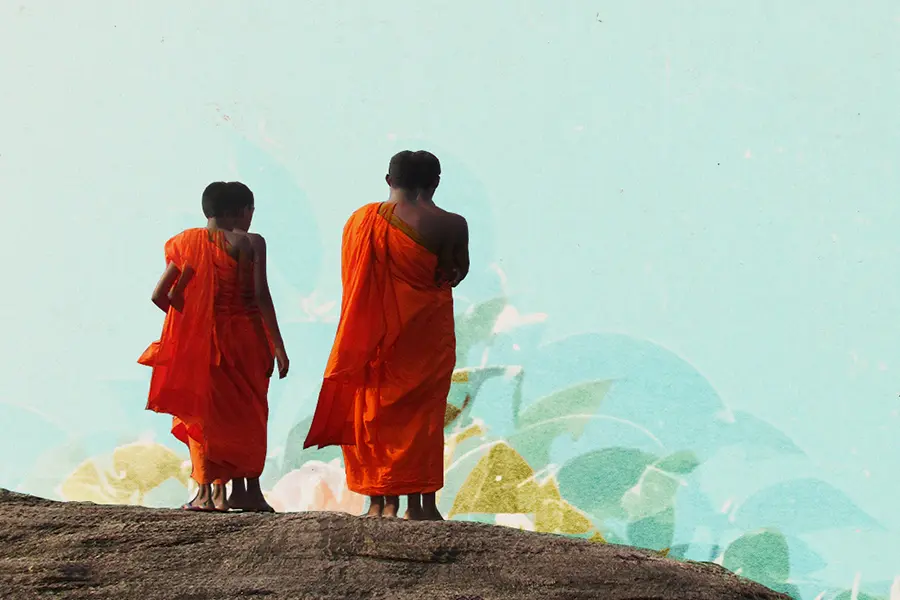Back in the early days of his psychedelic use—”before LSD was illegal”—Mike Crowly had a vivid experience on acid that he later found could be described in the texts of renowned Buddhist masters. “There are two explanations for this,” he tells DoubleBlind. “One, that my dose of psychedelics had allowed me access to something that was only previously available to profound meditators. Or, the other explanation is that they were all doing psychedelics, too.”
Describing the experience in his book, Secret Drugs of Buddhism: Psychedelic Sacraments and the Origins of the Vajrayana, he writes: “Either way, this was thrilling confirmation that I was on the right track and that, if used correctly, psychedelics held the key to deeper spiritual exploration.”
Crowley went on to study with a Tibetan Buddhist lama for over 20 years, and eventually became one himself. But indeed, he never stopped tripping, but rather pursued the dual practice of psychedelics and meditation—even though Buddhists have a reputation for living drug- and alcohol-free. Those who choose Buddhism often take vows concerning an ethical way of life. One of those vows, known as the “fifth precept,” is interpreted as abstaining from intoxicants, given their perceived tendency to “cloud the mind.”
But interpreting the fifth precept to preclude anything psychoactive, says Crowley, isn’t the only valid way. Some people believe the authors of the precepts intended to prohibit alcohol only. “I took my vows in Tibetan,” he jokes, “and the only thing I vowed to abstain from is chaang, or beer.”
Read: Goodbye, Ram Dass. We Love You.
Undertaking a decades-long study of Buddhist texts—including some from his own Tibetan Kagyud lineage and others from the Indian Vajrayana tradition—Crowley found repeated references to something called amrita. Translated as “deathless” or “nectar,” amrita was a psychoactive elixir used in sacraments on a large scale in the Buddhist world during the Middle Ages, Crowley holds.
Amrita has been described as powerful enough to soften the boundaries between ordinary states of being and enlightened ones, but scholars still debate what it was actually made of. Some say it was a mixture containing cannabis and others point to ephedra, but Crowley believes it was made of psilocybe cubensis, i.e. magic mushrooms. He points to recurrent themes in Buddhist art such as the bump often found on the Buddha’s head that mirrors a bump that grows on the caps of shrooms. In Tantric art, water buffaloes, too, may reference another psychedelic mushroom, panaeolus cambodginiensis, that sprouts upon their dung.
How to Grow Shrooms Bundle
Take Both of Our Courses and Save $90!
But even though Crowley continues to integrate psychedelics into his spiritual practice in a conscious way, he does so only a couple of times a year.
“Psychedelics allow us to see the nature of mind—which is the main point,” he says. But insight on its own isn’t nearly as powerful as insight coupled with daily practice and techniques to integrate psychedelic insights into mundane life. Meditation, says Crowley, drives and informs his relationship to psychedelics.
Secret Drugs of Buddhism is now out in its second edition, while Crowley writes another book on the subject: a type of user manual for Buddhists seeking to bring psychedelics to their practice. While his undertaking may distance him from some fellow Buddhists, and requires advanced literacy in historic texts, Crowley says that he wanted to dispel the myth that Buddhist practice must be free of any kind of mind-altering substance to be considered “real Buddhism.”
He says he’d always expected someone else to write an exhaustive book on the subject. “I waited for over twenty years,” he says, “and because no one had done it, I did it myself.”

DoubleBlind is a trusted resource for news, evidence-based education, and reporting on psychedelics. We work with leading medical professionals, scientific researchers, journalists, mycologists, indigenous stewards, and cultural pioneers. Read about our editorial policy and fact-checking process here.

DoubleBlind Magazine does not encourage or condone any illegal activities, including but not limited to the use of illegal substances. We do not provide mental health, clinical, or medical services. We are not a substitute for medical, psychological, or psychiatric diagnosis, treatment, or advice. If you are in a crisis or if you or any other person may be in danger or experiencing a mental health emergency, immediately call 911 or your local emergency resources. If you are considering suicide, please call 988 to connect with the National Suicide Prevention Lifeline.



